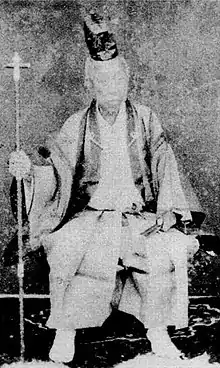Prince Fushimi Kuniie
Prince Fushimi Kuniie (伏見宮邦家親王, Fushimi-no-miya Kuniie-shinnō, 24 October 1802 – 5 August 1872) was Japanese royalty. He was the 20th/23rd prince Fushimi-no-miya and the eldest son of Prince Fushimi Sadayuki (1776-1841)[1] and his concubine Seiko,[note 1] which made him an 11th cousin of Emperor Sakuramachi. Despite being merely a distant cousin to the emperors, he was adopted by Emperor Kōkaku as a Yūshi in 1817, which made him a Shinnō, or prince, just like an emperor's natural-born son.[1]
| Prince Fushimi Kuniie | |
|---|---|
 | |
| Prince Fushimi | |
| Reign | 1841-1842 |
| Predecessor | Prince Fushimi Sadayuki |
| Successor | Prince Fushimi Sadanori |
| Reign | 1864-1872 |
| Predecessor | Prince Fushimi Sadanaru |
| Successor | Prince Fushimi Sadanaru |
| Born | October 24, 1802 |
| Died | August 5, 1872 (aged 69) |
| Father | Prince Fushimi Sadayuki Emperor Kōkaku (adoptive father) |
Prince Kuniie succeeded to the title of Fushimi-no-miya after the death of his father in 1841. But soon, in 1842, his eldest (natural) son, Zaihan (later Prince Yamashina Akira) ran away with his aunt Princess Takako, while Zaihan was a monk in Kajū-ji. Because of this scandal, the prince soon had to abdicate in favor of the only son of his wife, Prince Sadanori, who was the sixth out of 17 sons of his father. Prince Kuniie took the name Zengaku (禪樂) as a monk afterwards. In 1864, Kuniie succeeded as Prince Fushimi-no-miya again. After Emperor Meiji moved the capital of Japan to Tokyo, Prince Kuniie left Kyoto and moved to Tokyo with his family in 1872. He abdicated again to his second son (or 14th), Prince Sadanaru, lived in seclusion, and died the same year.
He was the father of 17 princes and 14 princesses (9 of which were born before his marriage to Karatsukasa Hiroko in 1836), including Prince Kuni Asahiko, Prince Yamashina Akira, Prince Higashifushimi Yorihito, Prince Kitashirakawa Yoshihisa, Prince Fushimi Sadanaru, Prince Kan'in Kotohito, the grandfather of Japan's first post-World War II Prime Minister Prince Naruhiko Higashikuni, the great-grandfather of Empress Kōjun, and the great-great grandfather of Emperor Akihito. He was the common ancestor of Ōke.
Marriage and Children
On January 9, 1836, Prince Kuniie married Karatsukasa Hiroko (1814-1892), daughter of Takatsukasa Masahiro (also, a second cousin of Emperor Ninkō paternally). They had 7 children, with 2 sons and 1 daughter lived to adulthood:
- Prince Sadanori (伏見宮貞教親王 Fushimi-no-miya Sadanori shinnō), 26 October 1836 – 16 December 1862)
- Princess Fumiko (碌子女王), (1839 – 1853)
- A son (喜久宮 Kiku-no-miya), (1842 – 1851)
- Princess Noriko (則子女王), (16 May 1850 – 14 November 1874), wife of Marquis Tokugawa Mochitsugu.
- A daughter (嘉世宮 Kayo-no-miya), (1852 – 1853)
- A daughter (利宮 Toshi-no-miya), (1856 – 1858)
- Prince Fushimi Sadanaru (伏見宮貞愛親王 Fushimi-no-miya Sadanaru shinnō), (9 June 1858 – 4 February 1923)
In addition, Kuniie had additional 24 children by nine of his concubines, with 10 sons and 7 daughters lived to adulthood:
- Prince Yamashina Akira (山階宮晃親王 Yamashina-no-miya Akira shinnō), (22 October 1816 – 29 October 1891), by Fujiki Toshiko.
- Prince Yoshikoto (聖護院宮嘉言親王 Shōgoin-no-miya Yoshikoto shinnō), (28 February 1821 – 26 September 1868), by Fujiki Toshiko.
- Prince Jonin (曼殊院宮譲仁親王 Manshuin-no-miya Jonin shinnō), (1824 – 1842), by Fujiki Toshiko.
- Prince Kuni Asahiko (久邇宮朝彦親王 Kuni-no-miya Asahiko shinnō), (27 February 1824 – 25 October 1891), by Torikoji Nobuko.
- Princess Hisako (恒子女王), (26 February 1826 – 1916), by Ueno Juno. Wife of Nijō Nariyuki.
- Princess Yoriko (順子女王), (1827 – 1908), by Nakamura Soma.
- Koga Sei'en (久我誓円), (1828 – 1910), by Nakamura Soma. Born Maki-no-miya (萬喜宮). She became a Buddhist nun of Zenkō-ji in 1835; she titularly became an adopted daughter of Koga Michiaki (1780-1855) in 1875.[2]
- Princess Tomoko (和子女王), (19 January 1830 – 4 June 1884), by Furuyama Chie.
- A stillborn son (微妙院 Bimyō-in), (1832 – 1832)
- A stillborn daughter (菩提院 Bodai-in), (1840 -1840), by Horiuchi Nobuko.
- Prince Komatsu Akihito (小松宮彰仁親王 Komatsu-no-miya Akihito shinnō), (11 February 1846 – 18 February 1903), by Horiuchi Nobuko.
- Prince Kitashirakawa Yoshihisa (北白川宮能久親王 Kitashirakawa-no-miya Yoshihisa-shinnō), (1 April 1847 – 5 November 1895), by Horiuchi Nobuko.
- A son (誠宮 Aki-no-miya), (1848 – 1853), by Horiuchi Nobuko.
- A son (愛宮 Naru-no-miya), (1849 – 1851), by Horiuchi Nobuko.
- Prince Kachō Hirotsune (華頂宮博経親王 Kachō-no-miya Hirotsune shinnō), (19 April 1851 – 24 May 1876), by Horiuchi Nobuko
- Prince Kitashirakawa Satonari (北白川宮智成親王 Kitashirakawa-no-miya Satonari shinnō), (22 July 1850 – 10 February 1872), by Itami Yoshiko.
- Murakumo Nichi'ei (村雲日栄), (3 April 1855 – 1920), by Itami Yoshiko. Born Masa-no-miya (萬佐宮) and later became a Buddhist nun.
- Princess Takako (貴子女王), (4 January 1858 – 1919),by Itami Yoshiko. Wife of Matsudaira Tadataka.
- A stillborn daughter (歡樂院 Kanraku-in), (1859 – 1859), by Itami Yoshiko.
- A daughter (多明宮 Tame-no-miya), (1860 –1864), by Itami Yoshiko.
- Count Kiyosu Ienori (清棲家教伯爵), (19 June 1862 – 13 July 1923), (adopted by Takatsukasa Masamichi, and reduced from Imperial status to nobility), by Itami Yoshiko.
- Prince Kan'in Kotohito (閑院宮載仁親王 Kan'in-no-miya Kotohito shinnō), (10 November 1865 – 21 May 1945), by Itami Yoshiko.
- Prince Higashifushimi Yorihito (東伏見宮依仁親王 Higashifushimi-no-miya Yorihito shinnō), (19 September 1867 – 27 June 1922), by Itami Yoshiko.
- A daughter (萬千宮 Machi-no-miya), (1869 –1872), by Itami Yoshiko.
Among 12 surviving sons of Prince Kuniie, 2 of them succeeded Fushimi-no-miya, other 9 were granted with Shinnōke and the other one became a count.
Ancestry
| Ancestors of Prince Fushimi Kuniie[3] | |||||||||||||||||||||||||||||||||||||||||||||||||||||||||||||||||||||||||||||||||||||||||||||||||||||||||||||||||||||||||||||||||||||||||||||||||||||||||||||||||||||||||||||||||||||||||||||||||||||||||||||||||||||||||||||||||||||||||||||||||||||||||||||||||||||||||||||||||||||||||||||||||||||||||||||||||||||||||||||||||||||||||||||||||||||||||||||||||||||||||||||||||||||||||||||||||||||||||||||||||||||||||||||||||||||||||||||||||||||||||||||||||||||||||||||||||||
|---|---|---|---|---|---|---|---|---|---|---|---|---|---|---|---|---|---|---|---|---|---|---|---|---|---|---|---|---|---|---|---|---|---|---|---|---|---|---|---|---|---|---|---|---|---|---|---|---|---|---|---|---|---|---|---|---|---|---|---|---|---|---|---|---|---|---|---|---|---|---|---|---|---|---|---|---|---|---|---|---|---|---|---|---|---|---|---|---|---|---|---|---|---|---|---|---|---|---|---|---|---|---|---|---|---|---|---|---|---|---|---|---|---|---|---|---|---|---|---|---|---|---|---|---|---|---|---|---|---|---|---|---|---|---|---|---|---|---|---|---|---|---|---|---|---|---|---|---|---|---|---|---|---|---|---|---|---|---|---|---|---|---|---|---|---|---|---|---|---|---|---|---|---|---|---|---|---|---|---|---|---|---|---|---|---|---|---|---|---|---|---|---|---|---|---|---|---|---|---|---|---|---|---|---|---|---|---|---|---|---|---|---|---|---|---|---|---|---|---|---|---|---|---|---|---|---|---|---|---|---|---|---|---|---|---|---|---|---|---|---|---|---|---|---|---|---|---|---|---|---|---|---|---|---|---|---|---|---|---|---|---|---|---|---|---|---|---|---|---|---|---|---|---|---|---|---|---|---|---|---|---|---|---|---|---|---|---|---|---|---|---|---|---|---|---|---|---|---|---|---|---|---|---|---|---|---|---|---|---|---|---|---|---|---|---|---|---|---|---|---|---|---|---|---|---|---|---|---|---|---|---|---|---|---|---|---|---|---|---|---|---|---|---|---|---|---|---|---|---|---|---|---|---|---|---|---|---|---|---|---|---|---|---|---|---|---|---|---|---|---|---|---|---|---|---|---|---|---|---|---|---|---|---|---|---|---|---|---|---|---|---|---|---|---|---|---|---|---|---|---|---|---|---|---|---|---|---|---|---|---|---|---|---|---|---|---|---|---|---|---|---|---|---|---|---|---|---|---|---|---|---|---|---|---|---|---|---|---|---|---|---|---|---|---|---|---|---|---|---|---|---|---|---|---|---|---|---|---|---|---|---|---|---|---|---|---|---|
| |||||||||||||||||||||||||||||||||||||||||||||||||||||||||||||||||||||||||||||||||||||||||||||||||||||||||||||||||||||||||||||||||||||||||||||||||||||||||||||||||||||||||||||||||||||||||||||||||||||||||||||||||||||||||||||||||||||||||||||||||||||||||||||||||||||||||||||||||||||||||||||||||||||||||||||||||||||||||||||||||||||||||||||||||||||||||||||||||||||||||||||||||||||||||||||||||||||||||||||||||||||||||||||||||||||||||||||||||||||||||||||||||||||||||||||||||||
Notes
References
- "『 親 王 ・ 諸 王 略 傳 』 邦 [邦家]". Archived from the original on 2006-05-06. Retrieved 2018-02-13.
- http://jodoshuzensho.jp/daijiten/index.php/久我誓円
- "Genealogy". Reichsarchiv (in Japanese). Retrieved 15 December 2020.